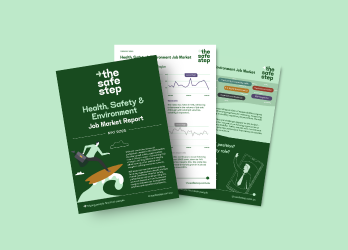HSE In 2023! A Year Of Change
Page Published Date:
February 16, 2023
We predict a busy year of change for health and safety

It looks like a year of change for the work health and safety profession in 2023. HSE portfolios look set to expand and skillsets will shift as technology, sustainability, wellbeing and economic factors all come to bear. In this opinion piece, we peer through our (murky) crystal ball and predict what a year of change ahead may look like for workplace health, safety and environment professionals.
HSE at an inflection point?
With January behind us, and the business year now in full swing, it’s a good time to look ahead and ask: what lies in store for HSE professionals in 2023?
The only problem with making predictions is that the crystal ball is a bit murky. As it happens, it’s been that way for the last 3 years. Commentators have no idea what unemployment, GDP or inflation will be by the end of the year, so it’s hard be confident about the operating environment.
As an example, nobody predicted that national retail sales would be running $5 billion a month ahead of the pandemic trend towards the end of the 2022. On the flip side, energy prices and supply chain issues are all externalities that make predictions fraught.
Notwithstanding this, specifically for the HSE profession, it looks like a year of change. Indeed, it could be said that the HSE profession is at a generational inflection point. Time will tell us more. Read on to better understand what will change in HSE and what’s driving this potential shift? What will change in HSE?
The remit of health and safety expanding...
From a range of anecdotal discussions in the market, it would appear that HSE functions could well be asked to manage broader portfolios in the year ahead. A continued focus on areas such as wellbeing, psychosocial risk, environment and sustainability is blurring the lines between the safety, risk, human resources, communications, government relations and legal functions.
Sustainability - a big place to play in!
In just one area of role expansion for HSE professionals, the market for talent surrounding sustainability is only going to get hotter. It's a big space to play in. Stakeholders ranging from the government to private investors and the community as a whole want improved trust and transparency around sustainability issues. In response, organisations are rethinking sustainable performance, and what it means to be successful.
The ‘E’ in HSE is rising in prominence as Environmental, Social and Governance (ESG) metrics become increasingly linked to performance and not just compliance. HSE leaders are now being tasked to target, manage, measure, and report sustainability performance, value and lasting impacts by company boards, external stakeholders and current and potential employees. This offers significant learning and growth opportunities for those within the HSE profession!
Big questions arise about future organisation design of the function: Does sustainability fold under HSE? Does sustainability become the umbrella role for HSE, P&C, Risk and other functions?
The reality is that there is no clear answer that covers all sectors. In some sectors, such as heavy industries for instance, sustainability easily fits in the HSE remit but in others such as Banking and Financial Services, the risk culture that is driven by the ballooning risk functions will probably incorporate sustainability (and then it just becomes all about compliance).
Changing roles & capability requirements
Matters of wellbeing and psychosocial risk also contribute to HSE’s portfolio expansion. Inevitably, change in capabilities, structures and roles will follow as functions accommodate this expanded remit. The worry of course for the HSE function is that as these areas increasingly become higher profile, other disciplines like the bean counters and lawyers will take over and want to focus on the process and legislation rather than organisation performance and cultural benefits.
Technology and the rise of AI and analytics
There is a well documented discussion in the media about ways to leverage ChatGPT and the current revolution of Large Language Models (LLMs). The text-generating AI bot is being looked at by a range of industries to assist and support work where there is sheer volume. HSE's confluence of legislation and regulation, sitting alongside data collection, checking and analysis, provides the perfect scenario for deploying AI.
What can this technology do now? LLMs can write code and answer questions. The Australian Financial Review recently reported that AI provides an opportunity to redesign work, saying: “The move reflects a changing make-up of the white-collar workforce as predicted by Microsoft co-founder Bill Gates, who said increasingly intelligent generative AI will remove the need for human professionals to perform some tasks related to report writing and data gathering and presentation,”.(It's interesting to note that Microsoft has invested $10 billion into ChatGPT valuing it at $49 billion – not bad since its only been around 6 months).
So it's likely that as 2023 progresses, the conversation will focus on insights that are achievable through AI analytics. It makes sense that much of the white-collar grunt work will be replaced. Technological advances will support better and more informed HSE initiatives and deliver greater impact where it counts.
Managing psychosocial risk... more expansion
It's reasonable to assume that psychological risk will continue to be a growing focus in the year ahead. HSE professionals will most likely be tasked with responding to changes in legislation and organisational obligations to manage mental health as a cultural driver.
As testimony to the interest and focus in this area, The Safe Step hosted a webinar in late 2022 that over 1300 people attended. This is not just a key area of risk to manage, but also a true proactive opportunity for HSE to support positive cultures in organisations and drive change.
Learn more about ways that organisations can improve effectiveness of psychosocial risk management.
Talent shortages continue
Even in a potentially softening economy, there are still talent shortages – the unemployment rate still has a 3 in front of it! Some of the obvious pinch points are well publicised, but some areas experiencing talent shortages are gaining less attention. Within construction, infrastructure and utilities, for example, demand continues to outstrip supply. A massive pipeline of work across the nation, suggests demand for health and safety professionals in this sector won’t let up in 2023.
...but there are job market changes
As reported in The Safe Step’s HSE Job Index, a changing economy may lead to a changing job market in the year ahead. Industries experiencing cost reduction pressures may look to replace permanent headcount with temporary positions. Whilst this may lead to a rise in the range of interim/contract opportunities available to health and safety professionals, it becomes a challenge for employees who remain in the function, with some being expected to wear multiple hats in the year ahead. A shifting employment cycle creates opportunity, but also stretches capacity
Interestingly, expected increased demand for contractors/consultants coincides with a significant number of HSE professionals anecdotally indicating that they are favouring interim assignments as a portfolio approach to maintain flexible work patterns.
How can we help?
2023 will no doubt be an interesting year for workplace health and safety functions. Adjustments in the organisation design of the function, along with emerging technologies and a softening economy, will mean that change will be very much at the forefront for HSE and the HSE talent market in 2023.
If you are looking to hire a workplace health and safety professional or are searching for a new HSE role please reach out to Craig, your Safe Step consultant or contact us to speak to a team member in your region for a further discussion.
Craig Mason is the Founder of The Safe Step. Craig is one of Australia's most experienced recruitment consultants and talent resourcers




